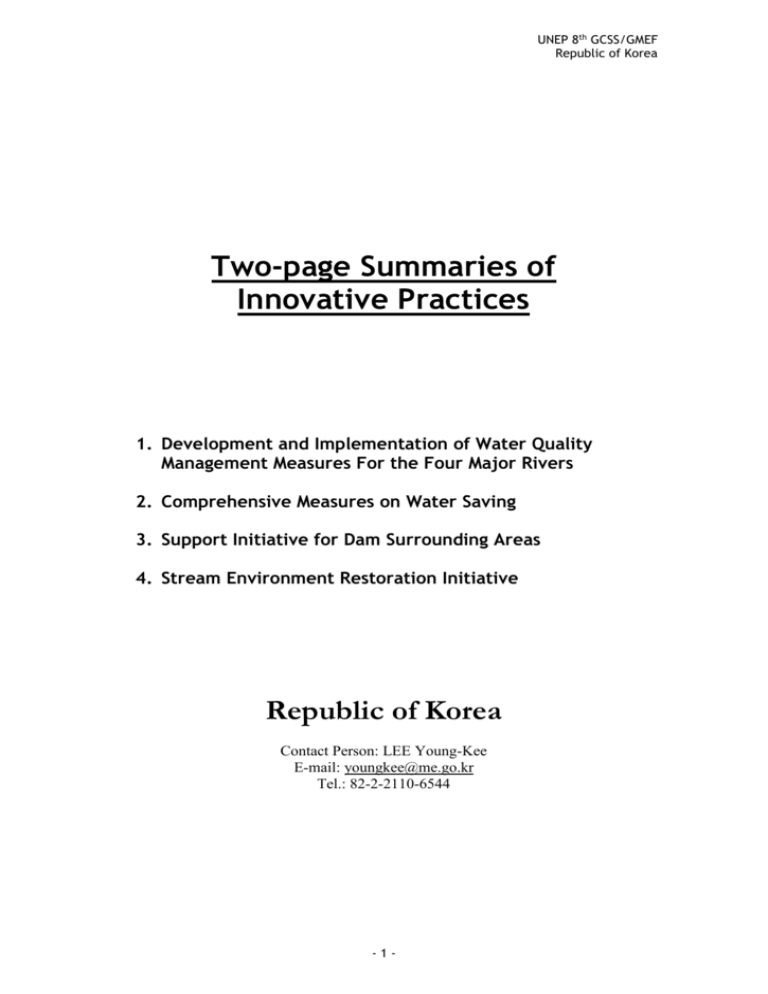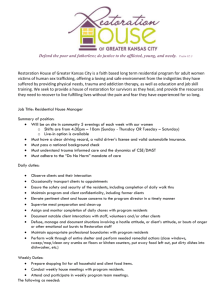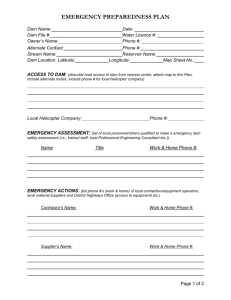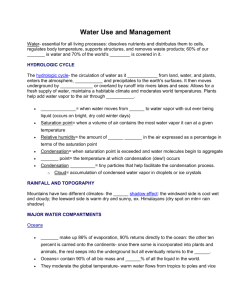Word - UNEP
advertisement

UNEP 8th GCSS/GMEF Republic of Korea Two-page Summaries of Innovative Practices 1. Development and Implementation of Water Quality Management Measures For the Four Major Rivers 2. Comprehensive Measures on Water Saving 3. Support Initiative for Dam Surrounding Areas 4. Stream Environment Restoration Initiative Republic of Korea Contact Person: LEE Young-Kee E-mail: youngkee@me.go.kr Tel.: 82-2-2110-6544 -1- UNEP 8th GCSS/GMEF Republic of Korea 1.Development and Implementation of Water Quality Management Measures For the Four Major Rivers Description of Initiative The Republic of Korea (ROK), which has a population density of 473 persons/km 2 (2002 figures, 4th highest in the world), lacks reliable water supply sources like groundwater and thus heavily relies on surface water such as rivers and streams for water supply. The country can be categorized into four major river basin areas (Han, Nakdong, Geum, and Yeongsan Rivers), and the water collected from these rivers meets the needs of more than 40 million residents in the Republic of Korea: 20 million people in the Han River basin, 13 million people in the Nakdong River basin, and 7 million people in Geum and Yeongsan River basin areas. Beginning with the establishment of comprehensive measures on water quality management of Han River in 1998, the ROK Government put into place specific measures for Nakdong River in 1999 and Geum and Yeongsan Rivers in 2000. These measures aim at ensuring the safety of water supply sources by bringing up the quality of raw water to Grade 1-2 by the year 2005 for some rivers and 2011 for others. To this end, ROK has devised detailed action plans to facilitate investment in large-scale water cleaning facilities as well as to provide support to upstream residents. Although these Water Quality Management Measures for the Four Major Rivers have different dates of establishment and target areas, they are all based on four fundamental principles and strategies. First: the creation of an integrated watershed community and equitable cost sharing strategies through the imposition of a ‘Water Use Charge.’ This water use charge is imposed in addition to the water service tariff, in proportion to the amount of water usage, and for the sole purpose of financing water quality management measures. In order to protect water resources that flow from upstream to downstream in an integrated manner and to help forge a cooperative relationship between upstream and downstream residents, ROK levies a water use charge on downstream residents to compensate for the land use regulations that are in effect for upstream residents. The revenue collected from this charge is used to support upstream community projects and construct water cleaning facilities. <Water Use Charge Imposition Rate> Watershed/ Category Rate (won/ton) Total Amount (billion won) Han River Nakdong River Geum River Yeongsan River 120 110 130 130 296.6 137.3 50.4 40.0 • Support upstream community projects • Land purchase in watershed areas • Support construction of sewage treatment facilities, etc. in upstream areas (Note: 1 USD = 1,200 Won) Usage Second: the integration of the precautionary principle into water resource management. ROK prevents reckless development in waterside areas by designating riparian buffer zones along upstream riverbanks (500m-1km from the water edge) and also directly purchases waterside land in order to minimize the number of potential sources of environmental pollution. -2- UNEP 8th GCSS/GMEF Republic of Korea Third: Integrated Water Resource Management (IWRM) that takes into consideration the characteristics of each river basin based on the Total Water Pollution Load (TWPL) management system. The TWPL management system is designed to control the water quality of the four rivers by obligating local governments to keep the pollution level of the river under their jurisdiction below the allowable pollution level, which has been differentially set based on the results of an environmental survey conducted in each river basin. This system will be implemented in stages from 2004 to 2008. The TWPL management system is significant in how it marks a move away from fragmentary government-led regulations of the past to more coherent policies that allow for both the achievement of water quality targets and regional development, while progressing towards sustainable development. Fourth: the principle of stakeholder participation. In the process of formulating comprehensive water quality management measures for the four rivers, the government considered and reflected the views of 11 ministries and local governments, along with the varied input from affected residents, NGOs and experts. In this policy making process, cooperation among different stakeholders played a critical role. In the case of the Han River management measures, numerous presentation and discussion sessions were held with the participation of civil society, the National Assembly, and local residents. In 1998, a public hearing on the draft management measures was even cancelled due to vocal opposition from local residents, putting the whole matter on hold. However, through persistent efforts of the government and the voluntary cooperation of NGOs, ROK succeeded in finalizing these measures. While drafting water quality measures for the other three major rivers, divergent views and conflicts emerged from upstream and downstream regions, urban and rural regions, main river and tributary regions, as well as from inside and outside the river basin areas. Through more than 70 forums and public hearings for Nakdong River, and 30 forums for Geum and Yeongsan Rivers, the government explicated and clarified the overall policy direction, and widely assessed the interests and demands of affected residents and civil society. Through these efforts, ROK followed the 1999 enactment of Han River legislation with the establishment of special laws for the other rivers in 2001, and finally completed the institutionalization of the comprehensive measures on water quality management for all major rivers. These measures signify a big step forward in securing safe water supply sources - the issue that has become one of the most critical challenges for the 21 st century both domestically and internationally – and further promotes the development of environmental policies within the framework of pollution prevention. Total Year of Establishment Implementation Period Total Cost 11.1118 (Unit: trillion won) (4.7610) (Investment as of 2002) Enforcement of the Special Acts (Note: 1 USD = 1,200 Won) Han River Nov 1998 1998-2005 Nakdong River Dec 1999 1999-2008 2.6385 (1.7107) 4.2472 (2.944) Aug 1999 July 2002 Geum River Oct 2000 2000-2011 2.7240 (656.5 billion) Yeongsan River Oct 2000 2000-2011 1.5021 (299.4 billion) July 2002 July 2002 To actually implement the comprehensive measures for the four rivers, a budget of 11.1118 trillion won is necessary. From the establishment of measures for Han River basin in 1998 up to 2002, a total of 4.7610 trillion won has been invested in implementation efforts. Mainstreaming/ Sustainability One of the important features of the Water Quality Management Measures for the Four Major Rivers is the substantial consideration given to residents in areas that experience heightened -3- UNEP 8th GCSS/GMEF Republic of Korea regulations as a result of water quality improvement initiatives. The government imposes the water use charge to sustain the Water Management Fund for each river, and annually provides financial assistance to a considerable number of support projects for residents. In the case of the Han River basin, upstream resident support projects came into full force in 2000. Between 2000 and 2003, ROK invested 260.5 billion won in 8,946 projects to enhance residents’ welfare, raise their income level, and generally promote their standard of living. In Nakdong, Geum and Yeongsan River basins, resident support projects have been undertaken since 2003, with 59.9 billion won contributed in investment. As a result of consistent implementation of the innovative measures on the four rivers, the quality of water supply sources across the country is steadily improving. In particular, Paldang Resorvior, which serves 20 million people in the capital city and its vicinities, has seen an improvement in BOD levels from 1.5 mg/l in 1998 to 1.3 mg/l at the end of 2003. This initiative demonstrates that in order to achieve IWRM, improved sanitation, and other water-related targets of the Millennium Development Goals and the Johannesburg Plan of Implementation, coherent formulation of mid- to long-term plans is critical, as are persistent efforts by the government to secure stable financial resources for their implementation. Replicating the Initiative To protect water supply sources in major rivers and to effectively improve water quality, the efforts of local governments must be complemented by comprehensive, integrated mechanisms and efforts at the national level. The creation of cooperative working relationships between various stakeholders, including the government, local residents, and civil society is especially important since by nature, policies regarding river basins affect various stakeholders and as can be seen in the experience of ROK, dialogue and collaboration are required for successful implementation. Also, scientific studies and monitoring are instrumental. Lastly, concerted efforts are required in order to equitably distribute the benefits of water quality regulations among those who are positively and negatively affected by those regulations, for example through the imposition and utilization of a water use charge. By promoting economic and environmental equity in river basin areas, resident participation in and awareness of national water quality improvement measures can increase, as will ground-level involvement in sustainable development efforts. -4- UNEP 8th GCSS/GMEF Republic of Korea 2.Comprehensive Measures on Water Saving Description of Initiative The Republic of Korea is situated with insufficient water resources due to a low annual precipitation per capita (1,705 m³/year, one tenth of the world's average). However, the nation marks a relatively high water consumption level (2002, 362 l/capita). Diminishing amounts of land suited for dam construction, rising construction costs, and environmental problems have interfered with the development of critical water resources, giving rise to the view that the government should shift from supply-oriented to demandoriented policy approaches. In this context, the Ministry of Environment established the Comprehensive Measures on Water Saving, specifically setting a target of 690 million tons in water savings by 2006. With the amendment of the Water Supply Act in 2001, the Government introduced various water saving measures including mandatory installation of water-saving facilities and water recycling systems, regeneration of superannuated water pipes, adoption of a water charge system, and the promotion of water-saving campaigns. < Major Features of the Comprehensive Plan> Designation of the National Water Saving Target Water saving goals determined by water business providers and public institutions Encouraging installation of water-saving devices at all households and/or buildings Expanding water-recycling systems Raising the renewal rate of superannuated water pipes Encouraging sewage/wastewater reuse Expanding facilities that utilize harvested rainwater Development and dissemination of education programs on water saving Promotion of nation-wide civil campaigns on water saving In particular, significant efforts were made in the area of raising citizen's awareness on water saving. The World Water Day was designated as one of the National Commemoration Days in 1995, and ROK bolstered its endeavors through the establishment of the “I Love Water” motto in 2000, promotion of the “Reducing Water Use by 50% Campaign” since 2002, and launch of the “I Love Water” homepage (www.ilovewater.or.kr). In light of these efforts, per capita water consumption was reduced from 380 liters in 2000 to 374 liters in 2001, and 362 liters in 2002, infrastructure was established that saved approximately 5,890,000 tons of water during 1999-2003, and wastewater and sewage treatment costs were reduced by 5 hundred billion Korean won. (Note: 1 USD = 1,200 Won) While implementing the measures, some obstacles were experienced due to lack of awareness on water saving, and due to the fact that water is often mistaken as an infinite natural resource. Moreover, water charges (10,000 won/month) are relatively low compared to other public utility charges like electricity, broadcasting, and transportation, resulting in weak incentives to save water. Civil participation plays a critical role in achieving water saving goals, therefore, long-term endeavors to raise public awareness, e.g. public relations campaigns and educational programs, are called for. In this regard, the Ministry of Environment is working hand in hand -5- UNEP 8th GCSS/GMEF Republic of Korea with major civil groups from the initial stages to promote joint water saving activities like civil awareness campaigns and monitoring of water saving. The central government, local governments, and civil groups should make concerted efforts to initiate water-saving measures. Furthermore, various water saving strategies such as installation of water-saving devices, adoption of water reuse systems, utilization of harvested rainwater should be reflected in the Water Supply Act and other related policies. Mainstreaming / Sustainability Local Governments allocate a portion of the Public Job Creation Support Budget towards temporary positions in charge of installing water-saving devices. Through this strategy, the Government aims at reducing the unemployment rate, while contributing to water-saving endeavors. Approximately 42 billion Korean won was allocated to cover the relevant expenditures during 1999-2003. Replicating the Initiative Directing private investments towards water-related projects, like superannuated water-pipe renewals, would serve as effective measures in securing sufficient financial resources. Sound water saving measures is key to achieving a 'win-win situation', in which water resources are efficiently used while consumers benefit from their saving activities. Therefore, nations with insufficient water resources are strongly encouraged to prioritize water saving measures, or to promote these measures in parallel with water resources development. -6- UNEP 8th GCSS/GMEF Republic of Korea 3.Support Initiative for Dam Surrounding Areas Description of Initiative The Support Initiative for Dam Surrounding Areas, led by the Ministry of Construction and Transportation, seeks to provide reparations for displaced or otherwise adversely affected residents due to dam construction. The Initiative aims to increase dam construction area residents’ per capita income, as well as promote their social welfare. For this purpose, beneficiaries from dam construction provide financial support to compensate for the harm caused to residents. In so doing, regional equity is promoted and the development of the water resources industry is able to progress more smoothly. Those who are eligible for compensation are residents of the region within 5km of the maximum reservoir water level of multipurpose dams and water supply dams that have a total reservoir volume exceeding 20 million m³ or a reservoir surface area exceeding 2 million m². For example, the initiative is being implemented in the surrounding areas of Chung-ju Dam, Dae-chung Dam, and An-dong Dam on the So-yang River in Gang-won Province. The reparations given in this support initiative are entirely provided by the dam operators and other profit-makers. From the completion of dam construction until its closing, i.e. throughout its full operation-cycle, 15% of revenues derived from selling water for drinking and industrial use as well as 3% of revenues derived from providing electricity will be contributed by the dam operator to the relevant region in order to fund the projects. Yearly expenditures on support initiatives are given below: Year 1998 1999 Billion 1.93 1.87 Won (Note: 1 USD = 1,200 Won) 2000 2001 2002 2003 2004 8.33 10.50 12.42 13.56 17.43 The main types of support initiatives taking place are geared towards 1) increasing resident income generation, i.e. the establishment of cooperative farming and cooperatively owned markets for selling goods produced by residents, construction of roads in rural farming areas, 2) promotion of social welfare initiatives, i.e. provision of medical insurance fees, establishment of community halls, construction of water supply and sewage facilities, and 3) education initiatives, i.e. provision of education equipment, materials, and scholarships, as well as other related initiatives. Because in most cases residents in dam construction areas are displaced and must move into new areas, their livelihoods and parts of their community are often lost. In trying to ameliorate these issues through the Support Initiative for Dam Surrounding Areas, the “Committee on the Support Initiative for Dam Surrounding Areas” has been organized so that the initiatives that the residents and regional society want are carried out. The “Committee on the Support Initiative for Dam Surrounding Areas” involves a wide array of stakeholders such as local government, the regional council, local experts, resident representatives, and dam operators. Through such membership, the Committee is working on the design and implementation of initiatives through collaborative discussion and the gathering of opinions of residents. This initiative is based upon the principle of joint management of upstream and downstream areas and is therefore practicing Integrated Water Resource Management (IWRM). Moreover, by providing compensation to those who are directly or indirectly harmed from dam construction, the initiative aims to promote regional and local equity –- an important part of sustainable development. Furthermore, basic infrastructure to support sustainable -7- UNEP 8th GCSS/GMEF Republic of Korea agriculture and rural development is being built, and support to rural and isolated areas has been strengthened. In particular, by taking into account regional conditions and through the involvement of all stakeholders, public-private partnerships are promoted by improving the accountability of both the public and private sectors. Mainstreaming/Sustainability There are plans to incorporate this initiative into National Social Overhead Capital Projects, which will actively contribute to national progress towards sustainable development and poverty eradication. Funding for the support initiatives has been secured and is contributed in full by the dam operators and beneficiaries. The allocation of reparations and the planning of the initiative is conducted through the “Committee on the Support Initiative for Dam Surrounding Areas.” Aspects of this initiative such as funding and purpose are outlined in the Law on the Support Initiative for Dam Construction and Surrounding Areas, as well as in related statutes. Also, a stable funding source has been established since portions of revenues generated from dam operation have been specifically earmarked for providing compensation to affected regions. Replicating the Initiative There are plans to introduce this initiative on providing reparations for dam construction areas and displaced residents through an official website (www.moct.go.kr), and to also actively promote the initiative when meeting other nations so that it may be replicated. The development of water resources, and dams in particular, is a controversial industry. There are numerous cases where harmful costs of environmental and human impact are generated at the same time as the benefits. Henceforth there is a critical need to design and implement mechanisms that offset the harmful costs through enabling the equal sharing of benefits in a creative and sustainable manner. The Support Initiative for Dam Surrounding Areas is a financially viable initiative that promotes regional equity and sustainable development in ways that actively address the improvement of health and sanitation conditions. It also applies the principle of Integrated Water Resources Management (IWRM) by treating the dam construction site, surrounding areas and river as one collective ecosystem in the long-term management and development of human settlements. -8- UNEP 8th GCSS/GMEF Republic of Korea 4. Stream Environment Restoration Initiative Description of Initiative The Stream Environment Restoration Initiative has been led by the Ministry of Construction and Transportation (MOCT) of the Republic of Korea since 1998 and has 7 pilot projects such as those at O-san Stream and Kyung-an Stream. This initiative promotes the restoration of aquatic ecosystems and the improvement of water quality by reorienting streams towards their natural conditions and away from their current artificial state of cement embankments and straightened water flow. Methods involve using natural materials such as soil, rocks, and trees to rebuild stream banks in order to provide habitats and breeding places for aquatic organisms, as well as promoting a variety of streambed environments so that wetlands and varying speeds of water flow may exist. Furthermore, the initiative aims to increase space for leisure activities near the stream environment, by providing green space with walking paths and hiking zones. These initiatives are organized and summarized below: Project Name Enforcement Restoration Authority Size Total Period 71.15km Phase 1: 1.8km Phase1: ‘98.6-’00.12 Phase 2: 13.5km Phase2: ’01.10-‘05.10 〃 22.5km ’01.5-’04.5 〃 16.3km ’03.5-’05.12 3.8km ’03.9-’05.12 O-San Stream City of Seoul Kyung-an Stream Hwang-gu-ji Stream Han River Nanji Landfill Site 〃 Sung-hwan Stream City of Daejon 8.0km ’01.11-’05.11 Kyung Stream City of Iksan 1.5km ’00.6-’02.12 Dong-bok Stream 〃 3.0km ’02.10-’05.9 For the systematic implementation of the initiative, a stream environment restoration framework plan is in the process of being established (to be completed in 2004.6), a comprehensive assessment of waterside environments along streams that flow through cities is being conducted (47 sites; 1,386km), and the prioritization of project areas based on regional conditions such as resident preferences, and historical and cultural heritage factors will guide the yearly implementation of the initiative (2005-2011). Furthermore, development of the requisite technology and capacity-building for establishing the implementation plan, as well as planning, design and construction in relation to the Stream Environment Restoration Initiative has been pursued (2000.7-2004.8). Because the initiative brings about positive results such as ecosystem restoration and guaranteed space for leisure activities, the residents living near the streams where the Stream Environment Restoration Initiative is being implemented are showing positive responses. This initiative adheres to the fundamental ideas of Integrated Water Resource Management (IWRM) by strengthening and restoring the resilience of freshwater ecosystems in the face of anthropogenic and natural pressures and by mitigating the negative effects of urbanization. In addition, by conducting waterside environmental surveys, local resident preference surveys, and taking into account the region’s historical and cultural conditions the initiative is being systematically implemented. -9- UNEP 8th GCSS/GMEF Republic of Korea In accordance with item IV.25.a of the Johannesburg Plan of Implementation (JPOI), stream restoration will increase the recharge rate of groundwater and thus contribute to efforts to reduce losses and increase the recycling of water through integrated stream basin and groundwater management. Also, in accordance with item IV.35.d of JPOI, the restoration of wetland areas within stream environments will reduce the adverse effects experienced from natural disasters such as flooding and drought. Henceforth, the Stream Environment Restoration Initiatives will be actively promoted through its incorporation into other initiatives, urban planning, and housing development that are of relevance to stream environments. Mainstreaming/Sustainability The budgeting process entails the MOCT submitting funding requests for the following year, in accordance with their mid- and long-term framework plan, to the Ministry of Planning and Budget, which then considers the request and allocates funds, taking into account the national budget at-large. Stable procurement of funding exists due to the fact that the expenditures for implementing the Stream Environment Restoration Initiative are provided by the National Treasury in full, and these funds are invested on an annual basis following the MOCT framework plan. Examples of the initiative and its operation progress will continue to be introduced at cooperative meetings with other countries, and there are plans to provide relevant information through an official website (www.moct.go.kr). Replicating the Initiative In the process of urbanization and industrialization, the practice of artificially channeling streams into straight waterways for the swift drainage of floodwater became standardized, bringing about a concomitant collection of environmental problems: streams were used as sewage drains for household wastewater causing stagnation, damage from flooding became more severe due to lack of space for currents to flow through, water quality deteriorated from pollution, and degradation of stream ecosystems became commonplace. This unfortunate reality is one that is shared by many regions, making this initiative for stream environment restoration widely applicable. For sustainable development and the eradication of poverty, implementation of IWRM initiatives such as stream environment restoration needs to be expanded. In particular, we would like to highlight how the quality of life in densely populated urban centers with high pressures on natural resources can be improved with respect to clean water, sanitation and health by restoring stream environments to their former state of beauty, biodiversity and natural water recycling. - 10 -








